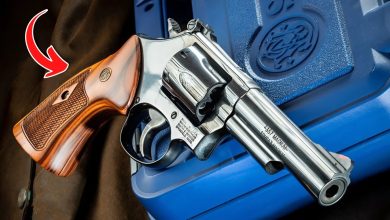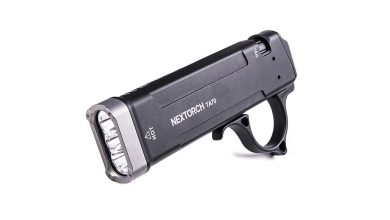Rifles: Installing Accuracy

When it comes to rifle shooting, “acceptable accuracy” is difficult to define concisely. Semantic irony aside, we can’t even agree on how to measure accuracy, let alone express it to everyone’s liking. Conversations on the subject can quickly devolve into lectures over mean radius versus extreme spread or the improper conflation of “precision” and “accuracy.” With luck, we get aggravated enough to settle for something like “minute-of-angle or better” as a framework, and then get back to picking up brass, looking for animal shapes in the clouds or whatever else we were doing.
Technical evaluations tend to focus on a rifle’s mechanical accuracy, or what it’s capable of when certain external influences are removed. The lab-like conditions required for these tests require time and resources few of us have. Practical accuracy, which a proficient shooter can achieve under normal conditions, is the more relevant aspect we usually test for on the range. But, much like the beholders of beauty, what constitutes acceptable practical accuracy is entirely in the eye of the “beshooter.”
Current technology constrains mechanical and practical rifle performance. Thanks to new discoveries, materials and manufacturing methods, however, this “industrial accuracy” advances over time. Looking back to the early metallic-cartridge era, we can see snapshots of how rifle performance has evolved to present-day levels.
In 1909, Dr. Franklin W. Mann published his extensively studied “From Flight to Target.” This immense body of test data was compiled over nearly four decades. In it, Mann detailed the mechanical accuracy of (mostly) single-shot rifles, with changes made to any variable he thought may impact performance. Mann’s better 100-yard, five-round groups hovered near 1 MOA, but he occasionally bested that mark. Even considering Mann’s tightly controlled test conditions, that was impressive accuracy for the period.
A year later, W. W. Greener’s 1910 edition of “The Gun and its Development” described a long-range record set in 1886. The shooter—noted firearm and ammunition designer George Gibbs—scored 48 out of 50 shots on a 36-inch bullseye at 1,000 yards, using the .461 cartridge he developed for a Metford breechloader. Greener showed that the two missed shots were just outside the edge of the bullseye, while all hits were well inside that circle. The resulting 1,000-yard accuracy record was approximately 3.4 MOA (1 MOA at 1,000 yards is 10.47 inches) at that time.
Most early 1900s reporting about practical accuracy was anecdotal, but clues still exist in contemporary publications like The American Rifleman. In the August 1931, issue, Allyn H. Tedman’s “Sighting ‘Small Deer’ Rifles” described suitable .22-caliber centerfire rifles and optics for small game. The author made clear that such rifles “must group inside the mystic 1-inch circle at 100 yards.”
Part two of COL Townsend Whelen’s “Only Accurate Rifles Are Interesting” series in the April 1957, issue, provided glimpses of competitive-rifle accuracy in his day. The author highlighted a series of 500-yard matches that were regularly won by the same rifleman in 1930. The competitor shot a heavy-barreled .30-‘06 Sprg. rifle that Whelen estimated averaged 1 MOA at that distance. Later, Whelen noted that by the mid-1950s, 1 MOA was common accuracy in both smallbore and 1,000-yard competitions.
These were skilled competitors, shooting accurized rifles and match or handloaded ammunition. Average shooters, rifles and ammunition were not yet at those levels. At the other end of the performance spectrum, the 1950 military specification for the M1 Garand (MIL-R-3285) provides a generous 100-yard accuracy standard of approximately 4.8 MOA at 100 yards when using elbows and a muzzle rest for support. That number was cut in half for the M1C sniper variant when supported by a mechanical rest and cradle. The 1971-dated specification for M14s (MIL-R-45012E) calls for approximately 3-MOA accuracy at 100 yards.
My Army experiences included both sides of the accuracy coin. Regardless of official specifications, my issued M16A1 and A2 rifles were considered accurate enough if I could hit anywhere on 19.5×40-inch silhouette at 300 meters using iron sights and ball ammunition. The accurized M4 variant I later carried averaged 6-inch (1.7-MOA) groups at 300 meters with backup sights.
According to my log books, my issued M21 sniper rifle averaged 1.4 MOA at 100 meters until its thin barrel got hot enough to wander. The beefier, first-generation SR25 that replaced it hovered at slightly less than 1.2 MOA, which was normal for those early models. So long as we did our jobs correctly, most of my unit’s MK11 MOD 0 rifles, which came next, were capable of sub-MOA accuracy out to 1,000 meters.
This rising arc of industrial accuracy has been in evidence on the commercial side of the house, too. At some point in the recent past, we surpassed the once-distant goal of affordable rifles capable of 1-MOA accuracy. Better still, premium rifles touting .75 MOA (or better) factory guarantees are no longer the exclusive realm of custom shops. The firearm version of splitting an arrow is the one-hole group. Aside from Benchrest competitions or mechanical-accuracy tests in lab settings, it’s safe to say we’re a long way off from consistently achieving that. So, what can we realistically expect in the near term?
The XPR family of bolt-action, modular-caliber rifles from HTI are advertised as 1/8-MOA shooters. No references are provided for evaluation methodology, ammunition, distance or conditions, so color me skeptical on that one. Still, I’m confident that continual improvements in rifle designs and materials, as well as the excellent work done by the most innovative ammunition manufacturers, will eventually yield affordable, off-the-shelf products that are capable of delivering quarter- to half-MOA performance in practical settings.
In his 1957 series, Whelen remarked that “The only limitation to skill in marksmanship is that imposed by the rifle and its ammunition.” I think the situation is reversed today. My biggest downrange shortcoming is an inability to consistently outshoot the capabilities of my best performing rifles. I hear the same thing from just about every serious (and honest) rifle shooter I talk to these days. That’s a credit to the current level of industrial accuracy.
To me, acceptable rifle accuracy is simply hitting where I aim. When I know my rifle isn’t the weakest link in that process, I can focus on all other elements of the system—especially me. Whether you’re attempting to connect ever-tougher shots at long distances or simply aiming to stack one round on top of the other, it’s unlikely that your rifle’s accuracy will be the thing that holds you back.
Read the full article here









